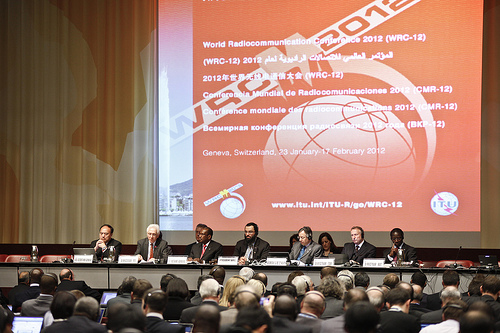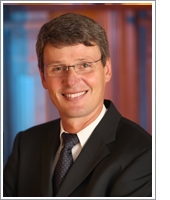Conference will set terms for future allocation of spectrum for mobile broadband services
The mobile world is waiting, preparing and girding itself for the annual glitz and grind of Mobile World Congress next month. But there is an event going on right now that has the potential to decide issues as significant for the future of the global mobile industry as anything discussed at MWC.
This is an event that is held only every three or four years, has no awards, celebrity parties, product launches or other shindigs. But it does have 3,000 top level regulators, legislators, technical advisors, lobbyists, liaison officers and other Governmental and quasi-Governmental officers from across the world. And it goes on for four weeks, from 23 January to 17 February.
The event is the World Radiocommunications Conference, known this year as WRC12, an ITU-run event held to discuss the future of radio spectrum allocation, and to place into binding international treaties regulations for the use of that spectrum.
Discussions at WRC work in two ways. First, the conference will seek international agreement on 35 agenda items that have formed the basis for four years’ deliberations and working group recommendations since the last WRC, held in 2007, determined the agenda for 2012. In this sense, according to Francois Rancy, Director of the ITU’s Radiocommunication Bureau, the WRC is just the “tip of the iceberg” of four years’ of work.
WRC will also look forward to its next meeting, in 2015, and place items on the agenda for 2015 that will set the direction of the next three year’s of working groups, SIGs and the like. WRC is a culmination, then, of ongoing work, negotiations and horse-trading. It also sets the ground rules and terms of reference for the next bout of discussions. “Every comma,” Rancy said, “matters.”
So what does WRC actually decide – and specifically what impact will those decisions have on the mobile industry?
In short, the WRC decides on global, harmonised radio spectrum allocations: from TV, to aviation use, to satellite and mobile broadband services. It binds those regulations into international law that all countries must agree to. This is vital because, as Rancy said to Mobile Europe, “Radio waves ignore borders.”
NEW SPECTRUM ALLOCATIONS FOR MOBILE
The mobile operators are represented, in part, at the WRC by their industry body, the GSMA. Roberto Ercole, Senior Director, Spectrum at the GSMA, told Mobile Europe that the GSMA’s principal aim this time around is to have an agenda item adopted for WRC2015 that will allocate additional frequency for mobile broadband services, thereby laying out which frequencies will be available from 2020 and beyond.
The mobile industry is concerned that although WRC2007 laid out frequency bands for mobile services in digital dividend spectrum at 800MHz, and also at 2.5GHz, that will not be enough to support the remarkable growth in mobile data services the industry has seen since 2007. The ITU’s prediction of mobile service demand was made in 2005, two years before the launch of the iPhone.
A piece from industry analyst Analysys Mason, written for the ITU’s own newsletter, argues that:
“Worldwide, it has been estimated that mobile traffic volumes in 2010 were seven times higher than those previously forecast in 2005, in preparation for WRC‑07, in ITU–R Report M.2072, World mobile telecoms market forecast. Both the volume and composition of mobile traffic have evolved considerably compared to industry expectations when ITU prepared M.2072.”
Ercole made the same point in a piece he wrote for the ITU, outlining the GSMA’s case and need for the 2015 agenda item. The UMTS Forum has also leant its shoulder to the wheel, publishing a White Paper titled ‘Spectrum for future development of IMT-2000 and IMT-Advanced’. The UMTS Forum urges the ITU to examine spectrum requirements for IMT, prior to timely identification of further bands. Specifically, it recommendeds that:
• The World Radiocommunication Conference 2012 (WRC-12) should adopt an Agenda Item for the WRC-15, allowing the identification of additional IMT spectrum;
• The ITU Radiocommunication Sector (ITU-R) should conduct during the next study period (between WRC-12 and WRC-15) thorough studies on future IMT spectrum requirements;
• The ITU should urge countries to coordinate their actions in order to harmonise IMT spectrum both before and during the WRC-15.
“Currently, there just isn’t enough spectrum to support the projected growth of mobile data”, states UMTS Forum Chairman Jean-Pierre Bienaimé. “The continuing growth of mobile broadband clearly relies on the identification of additional IMT spectrum”.
There is a perceived need, then, for an agenda item that will bring together a working group to assess bandwidth and spectrum demand, identify likely candidate frequency bands, recognise any problems in harmonising on those spectrum bands, identify any likely conflicts and so on.
Rancy pointed out that 800Mhz spectrum, identified at WRC2000, is only just coming online. 2.5GHz spectrum, allocated for mobile services at WRC2007, is still, mostly, completely unused. So the WRC moves a long way ahead, up to 5-10 years, of actual market implementation. That makes the correct identification of spectrum even more important – given that the industry needs certainty to bring economies of scale to the chips, devices and equipment that will operate in those bands.
“As much as possible having the same bands across the world, or regionally, boosts ecosystems, so driving the cost of devices down by having a bg enough market to encourage innovation and offer the products people want. That’s why this is important,” Ercole said.
Whatever frequencies WRC15 eventually decides, there seems little doubt that there will be an agenda item in place to decide on additional spectrum. With six regional bodies approving the item, its place looks secure.
Rancy added, “Clearly there is a need for more spectrum and this is why we all expect the agenda for the next conference will include new allocations which in turn will be used by 2020.” So discussions over the next three weeks will focus on the terms of that agenda item, the make-up of the working group, and the scope of the working group’s recommendations.
The GSMA’s Ercole did not want to be drawn on what likely the likely additional frequency bands would be. Analysys Mason’s analysts, however, identified the potential for a second digital dividend, at lower frequenciesthan 790MHz — but said that any such proposal would be controversial as it would impinge on plans for digital terrestrial TV use at those frequencies. In many cases TV signals have just been moved to those lower bands to free up 800MHz.
The “protection” of TV services is already a current concern of some governments at the WRC, according to Rancy, so further inroads into TV spectrum in favour of mobile services could be even more unwelcome.
AVIATION INTERFERENCE at 800MHz
There is one other live item of interest to mobile operators that does look set to be decided at WRC12, and that is the issue of dealing with interference between proposed mobile services at 800MHz and the current use of that band in many Eastern European countries for aviation communications.
Ercole said that Russia’s competing use of the digital dividend spectrum initially led to it demanding a 400km exclusion zone. That would have meant that in countries such as Poland and Finland, mobile use of those UHF frequencies would have been virtually impossible. But a solution seems to be in sight. For instance, Ercole said that Russia’s demands have come down to a 30km zone, which would help considerably.
Rancy said that there have been four years of talks to resolve these issues – and that he is hopeful that as a result there could be a “series of bilateral agreements that ensure the relocation of these systems into lower parts of the UHF band below 790MHz.” In other words, in some cases countries will agree to shift their aviation communications to lower channels, freeing up the 800MHz range for mobile services. The benefit of this approach, Rancy said, is that it would enable countries like Russia to use the 800MHz spectrum for mobile broadband as well.
“No country wishes to be out of step with what has been harmonised worldwide for broadband,” he added.










On allocation, acquisition and innovation
Three thousand people in a big room, and in several smaller ones, for four weeks — talking about harmonised spectrum allocation? That sounds like a party not to miss, for sure. But horrendous though the thought may be to contemplate, that is what has been occurring this week, and what will continue for the next three weeks, at the World Radiocommunications Conference in Geneva, where the ITU’s members are endeavouring to reach agreement on regulations determining spectrum usage.
Satisfying the demands of competing governments is not easy, but this is an important conference to track outcomes from, as one of the issues up for grabs is the allocation of additional spectrum for mobile broadband services from 2020.
We spoke to both the head of the RadioCommunications Bureau and the GSMA’s spectrum activity, to try and find out exactly what is at stake for the mobile industry over the next three weeks. In short, it seems that it is a done deal that the next big ITU spectrum conference, held in 2015, will decide what spectrum will be allocated to mobile broadband services, but the discussions and negotiations begin now. So when it comes to 2020, and operators are whinging about lack of spectrum (or a glut??) think back to this day, and those 3k people in a room in Geneva, determining our 5G future.
M&A activity continues apace in the industry. GigaOM reported this week, although nobody has been able to verify it, that Ericsson has decided to acquire small cell and WiFi vendor BelAir Networks. That would give Ericsson a public access (read, carrier-controlled) WiFi capability. Although neither company is willing to comment, industry watchers looking to put two and two together and come up with five may note the recent arrival at BelAir of Ronny Haraldsik as CMO. Ronny was at Flarion before it was sold to Qualcomm, and also at Shasta Networks and Bay Networks, both sold to Nortel. Probably means nothing, but worth nothing in a Firday afternoon conspiracy theory sort of a way, perhaps.
There was also a confirmed, but smaller value, acquisition in the OSS/BSS space, with Comptel adding the interesting customer analytics company Xtract. With the major NEPs all rumoured to be lining up CEM launches (and NSN already well down that road), it’s interesting to see that the OSS vendors are still adding CEM smarts to their portfolios. Somewhere in the network/policy/OSS/BSS space there will be clarity around CEM. Comptel’s “event-analysis-action” vision may be lacking the “proactive, predictive” element of some CEM pitches, but it makes sense, especially if integrated with real time charging capability.
Another interesting idea in a different, although related, area came from Stream Communications, which is providing dedicated 3G SIMs to tablet users with the promise of faster service. Details on this from Stream were sketchy, but essentially the company is using its M2M network capability to shuttle iPad and tablet traffic about. Whether this means that its M2M network is underutilised by actual M2M traffic is another matter. But it is an interesting idea to be able to offer prioritised, speedy service to end users on an individual basis, without entering the end-to-end, QoS-enabled, policy driven, customer centric CEM world as discussed in the paragraph above. Hard to see it scaling massively, though, but still a worthwhile enterprise play.
And finally… a new(ish) approach to SIM activiation
If you bought a SIM, would you want to be able to plug it in to your phone and then have it launch a small app that lets your phone communicate with you? It could ask you what number you would prefer, and perhaps ask you to pay a small amount for that number. Would you like to be able to even choose your tariff at that point?
This is a capability that Evolving Systems can offer to operators. At the moment, when operators push SIMs out into the market, to their own shops, and to kiosks, or stuck free SIMs on the front of magazines etc they need to have already provisioned those SIMs on their network.
That means pre-allocating space in their number ranges, and on their switches, for great bunches of SIMs that may never be activated, and may never therefore make them any money. But Evolving Systems lets operators provision SIMs at the point of activation. What it requires is an applet to be pre-loaded on the SIM, so the SIM manufacturers need to be involved before they deliver the “dynamic” SIMs to the operator. The operator obviously also needs to invest in a chunk of software from Evolving Systems.
Thad Dupper, CEO of Evolving Systems, said to me this week that operators could achieve between three and ten times return on their investment within 18 months to three years, by saving on switch and number range space, and also by generating new revenues by interacting with consumers when they activate the SIMs. By asking for user details, the dynamic SIM approach also drives user registrations – particularly apposite in markets with high numbers of prepaid users, he added.
You can look up Evolving Systems here.
Keith Dyer
Editor
Mobile Europe